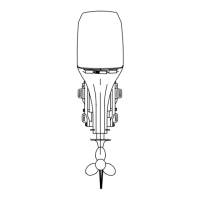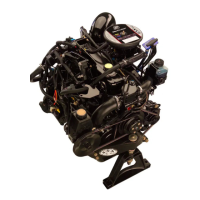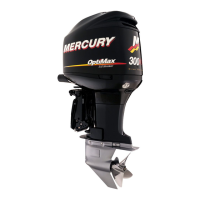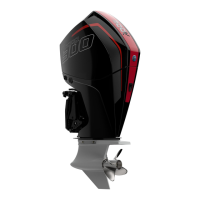26
90-10212R40
GB
oi
STORAGE
oia1
STORAGE PREPARATION
The major consideration in preparing your outboard for storage is to protect it from
rust, corrosion, and damage caused by freezing of trapped water.
The following storage procedures should be followed to prepare your outboard for
out-of-season storage or prolonged storage (two months or longer).
CAUTION
Never start or run your outboard (even momentarily) without water circu-
lating through the cooling water intake in the gear case to prevent dam-
age to the water pump (running dry) or overheating of the engine.
eib15
Fuel system
IMPORTANT: Gasoline containing alcohol (ethanol or methanol) can cause
a formation of acid during storage and can damage the fuel system. If the
gasoline being used contains alcohol, it is advisable to drain as much of the
remaining gasoline as possible from the fuel tank, remote fuel line, and
engine fuel system.
Fill the fuel tank and engine fuel system with treated (stabilized) fuel to help prevent
formation of varnish and gum. Proceed with following instructions.
1. Portable Fuel Tank – Pour the required amount of Gasoline Stabilizer (follow
instructions on container) into fuel tank. Tip fuel tank back and forth to mix
stabilizer with the fuel.
2. Permanently Installed Fuel Tank – Pour the required amount of Gasoline
Stabilizer (follow instructions on container) into a separate container and mix
with approximately one quart (one liter) of gasoline. Pour this mixture into fuel
tank.
Carburetor Models
3. Place the outboard in water or connect flushing attachment for circulating
cooling water. Run the engine for ten minutes to allow treated fuel to fill the fuel
system.
FUEL SYSTEM
Electronic Fuel Injection (EFI) Models
4. Remove the fuel filter sight bowl and empty contents in a suitable container.
Refer to Maintenance Section for removal and installation of filter. Add 3 cc (1/2
teaspoon) of gasoline stabilizer into the fuel filter sight bowl and reinstall.
5. Place the outboard in water or connect flushing attachment for circulating
cooling water. Run the engine for 15 minutes to allow treated fuel to fill the
engine fuel system.
oic4
Protecting External Outboard Components
1. Lubricate all outboard components listed in the Inspection and Maintenance
Schedule.
2. Touch up any paint nicks. See your dealer for touch-up paint.
3. Spray Quicksilver or Mercury Precision Lubricants Corrosion Guard on
external metal surfaces (except corrosion control anodes).
oid3
Protecting Internal Engine Components
1. Remove the spark plugs and inject a small amount of engine oil inside of each
cylinder.
2. Rotate the flywheel manually several times to distribute the oil in the cylinders.
Reinstall spark plugs.
3. Change the engine oil.
oie1
Gear Case
1. Drain and refill the gear case lubricant (refer to maintenance procedure).
oif3
Positioning Outboard for Storage
Store outboard in an upright (vertical) position to allow water to drain out of
outboard.
CAUTION
If outboard is stored tilted up in freezing temperature, trapped cooling
water or rain water that may have entered the propeller exhaust outlet in
the gear case could freeze and cause damage to the outboard.
oig1
Battery Storage
1. Follow the battery manufacturer’s instructions for storage and recharging.
2. Remove the battery from the boat and check water level. Recharge if
necessary.
3. Store the battery in a cool, dry place.
4. Periodically check the water level and recharge the battery during storage.
oj
TROUBLESHOOTING
ojb4
1 STARTER MOTOR WILL NOT CRANK THE ENGINE (ELECTRIC START
MODELS)
Possible Causes
• Blown 20 Amp fuse in the starting circuit (carburetor Models) or main power
relay/accessories circuit (EFI Models). Refer to Maintenance Section.
• Outboard is not shifted to neutral position.
• Weak battery or battery connections are loose or corroded.
• Ignition key switch failure.
• Wiring or electrical connection faulty.
• Starter motor or starter solenoid failure.
2 ENGINE WILL NOT START
Possible Causes
• Lanyard stop switch not in RUN position.
• Incorrect starting procedure. Refer to Operating Section.
• Old or contaminated gasoline.
• Engine flooded. Refer to Operating Section.
• Fuel is not reaching the engine.
a. Fuel tank is empty.
b. Fuel tank vent not open or restricted.
c. Fuel line is disconnected or kinked.
d. Primer bulb not squeezed.
e. Primer bulb check valve is faulty.
f. Fuel filter is obstructed. Refer to Maintenance Section.
g. Fuel pump failure.
h. Fuel tank filter obstructed.
• Blown 20 Amp fuse (EFI Models). Refer to Maintenance Section.
• Ignition system component failure.
• Wiring or electrical connection faulty.
• Spark plugs fouled or defective. Refer to Maintenance Section.
3 ENGINE RUNS ERRATICALLY
Possible Causes
• Low oil pressure. Check oil level.
• Spark plugs fouled or defective. Refer to Maintenance Section.
• Incorrect setup and adjustments.
• Fuel is being restricted to the engine.
a. Engine fuel filter is obstructed. Refer to Maintenance Section.
b. Fuel tank filter obstructed.
c. Stuck anti-siphon valve located on permanently built in type fuel tanks.
d. Fuel line is kinked or pinched.
• Fuel pump failure.
• Ignition system component failure.
• Fuel injection component failure (EFI Models).
4 PERFORMANCE LOSS
Possible Causes
• Low oil pressure. Check oil level.
• Throttle not fully open.
• Damaged or improper size propeller.
• Incorrect engine timing, adjustments, or setup.
• Boat overloaded or load improperly distributed.
• Excessive water in bilge.
• Boat bottom is dirty or damaged.
5 BATTERY WILL NOT HOLD CHARGE
Possible Causes
• Battery connections are loose or corroded.
• Low electrolyte level in battery.
• Worn out or inefficient battery.
• Excessive use of electrical accessories.
• Defective rectifier, alternator, or voltage regulator.

